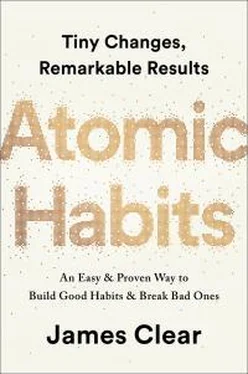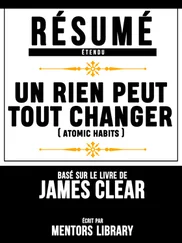Furthermore, genes can’t make you successful if you’re not doing the work. Yes, it’s possible that the ripped trainer at the gym has better genes, but if you haven’t put in the same reps, it’s impossible to say if you have been dealt a better or worse genetic hand. Until you work as hard as those you admire, don’t explain away their success as luck.
In summary, one of the best ways to ensure your habits remain satisfying over the long-run is to pick behaviors that align with your personality and skills. Work hard on the things that come easy.
Chapter Summary
The secret to maximizing your odds of success is to choose the right field of competition.
Pick the right habit and progress is easy. Pick the wrong habit and life is a struggle.
Genes cannot be easily changed, which means they provide a powerful advantage in favorable circumstances and a serious disadvantage in unfavorable circumstances.
Habits are easier when they align with your natural abilities. Choose the habits that best suit you.
Play a game that favors your strengths. If you can’t find a game that favors you, create one.
Genes do not eliminate the need for hard work. They clarify it. They tell us what to work hard on.
19 The Goldilocks Rule: How to Stay Motivated in Life and Work
IN 1955, Disneyland had just opened in Anaheim, California, when a ten-year-old boy walked in and asked for a job. Labor laws were loose back then and the boy managed to land a position selling guidebooks for $0.50 apiece.
Within a year, he had transitioned to Disney’s magic shop, where he learned tricks from the older employees. He experimented with jokes and tried out simple routines on visitors. Soon he discovered that what he loved was not performing magic but performing in general. He set his sights on becoming a comedian.
Beginning in his teenage years, he started performing in little clubs around Los Angeles. The crowds were small and his act was short. He was rarely on stage for more than five minutes. Most of the people in the crowd were too busy drinking or talking with friends to pay attention. One night, he literally delivered his stand-up routine to an empty club.
It wasn’t glamorous work, but there was no doubt he was getting better. His first routines would only last one or two minutes. By high school, his material had expanded to include a five-minute act and, a few years later, a ten-minute show. At nineteen, he was performing weekly for twenty minutes at a time. He had to read three poems during the show just to make the routine long enough, but his skills continued to progress.
He spent another decade experimenting, adjusting, and practicing. He took a job as a television writer and, gradually, he was able to land his own appearances on talk shows. By the mid-1970s, he had worked his way into being a regular guest on The Tonight Show and Saturday Night Live .
Finally, after nearly fifteen years of work, the young man rose to fame. He toured sixty cities in sixty-three days. Then seventy-two cities in eighty days. Then eighty-five cities in ninety days. He had 18,695 people attend one show in Ohio. Another 45,000 tickets were sold for his three-day show in New York. He catapulted to the top of his genre and became one of the most successful comedians of his time.
His name is Steve Martin.
Martin’s story offers a fascinating perspective on what it takes to stick with habits for the long run. Comedy is not for the timid. It is hard to imagine a situation that would strike fear into the hearts of more people than performing alone on stage and failing to get a single laugh. And yet Steve Martin faced this fear every week for eighteen years. In his words, “10 years spent learning, 4 years spent refining, and 4 years as a wild success.”
Why is it that some people, like Martin, stick with their habits—whether practicing jokes or drawing cartoons or playing guitar—while most of us struggle to stay motivated? How do we design habits that pull us in rather than ones that fade away? Scientists have been studying this question for many years. While there is still much to learn, one of the most consistent findings is that the way to maintain motivation and achieve peak levels of desire is to work on tasks of “just manageable difficulty.”
The human brain loves a challenge, but only if it is within an optimal zone of difficulty. If you love tennis and try to play a serious match against a four-year-old, you will quickly become bored. It’s too easy. You’ll win every point. In contrast, if you play a professional tennis player like Roger Federer or Serena Williams, you will quickly lose motivation because the match is too difficult.
Now consider playing tennis against someone who is your equal. As the game progresses, you win a few points and you lose a few. You have a good chance of winning, but only if you really try. Your focus narrows, distractions fade away, and you find yourself fully invested in the task at hand. This is a challenge of just manageable difficulty and it is a prime example of the Goldilocks Rule .
The Goldilocks Rule states that humans experience peak motivation when working on tasks that are right on the edge of their current abilities. Not too hard. Not too easy. Just right.
THE GOLDILOCKS RULE
FIGURE 15: Maximum motivation occurs when facing a challenge of just manageable difficulty. In psychology research this is known as the Yerkes–Dodson law, which describes the optimal level of arousal as the midpoint between boredom and anxiety.
Martin’s comedy career is an excellent example of the Goldilocks Rule in practice. Each year, he expanded his comedy routine—but only by a minute or two. He was always adding new material, but he also kept a few jokes that were guaranteed to get laughs. There were just enough victories to keep him motivated and just enough mistakes to keep him working hard.
When you’re starting a new habit, it’s important to keep the behavior as easy as possible so you can stick with it even when conditions aren’t perfect. This is an idea we covered in detail while discussing the 3rd Law of Behavior Change.
Once a habit has been established, however, it’s important to continue to advance in small ways. These little improvements and new challenges keep you engaged. And if you hit the Goldilocks Zone just right, you can achieve a flow state .*
A flow state is the experience of being “in the zone” and fully immersed in an activity. Scientists have tried to quantify this feeling. They found that to achieve a state of flow, a task must be roughly 4 percent beyond your current ability. In real life it’s typically not feasible to quantify the difficulty of an action in this way, but the core idea of the Goldilocks Rule remains: working on challenges of just manageable difficulty—something on the perimeter of your ability—seems crucial for maintaining motivation.
Improvement requires a delicate balance. You need to regularly search for challenges that push you to your edge while continuing to make enough progress to stay motivated. Behaviors need to remain novel in order for them to stay attractive and satisfying. Without variety, we get bored. And boredom is perhaps the greatest villain on the quest for self-improvement.
HOW TO STAY FOCUSED WHEN YOU GET BORED WORKING ON YOUR GOALS
After my baseball career ended, I was looking for a new sport. I joined a weightlifting team and one day an elite coach visited our gym. He had worked with thousands of athletes during his long career, including a few Olympians. I introduced myself and we began talking about the process of improvement.
“What’s the difference between the best athletes and everyone else?” I asked. “What do the really successful people do that most don’t?”
Читать дальше




![Джеймс Клир - Атомные привычки [Как приобрести хорошие привычки и избавиться от плохих]](/books/403243/dzhejms-klir-atomnye-privychki-kak-priobresti-horosh-thumb.webp)



